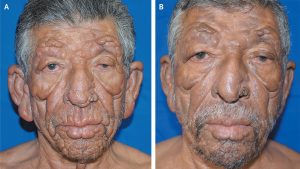A 57-year-old man with a seven-year history of left-hand sensory loss and facial nodular lesions sought medical attention. Facial muscle paralysis and nerve enlargement raised concerns. Ziehl–Neelsen staining confirmed acid-fast bacilli, leading to a lepromatous leprosy diagnosis.
Using the enzyme-linked immunosorbent assay, doctors screened for IgM antibodies to phenolic glycolipid I, specific to Mycobacterium leprae. The patient’s results were extremely positive, confirming lepromatous leprosy. This anergic form exhibits an ineffective immune response and gradual nerve injury development.
Multidrug therapy, combined with prednisone, was administered for five months. After nine months, significant improvement was noted, with diminished skin infiltration and frailty. For multibacillary leprosy, the standard treatment is 12 months; however, anergic polar forms like this patient often require extended treatment, typically 24 months, for a complete cure.
The case demonstrates the effectiveness of prolonged treatment in managing leprosy. Monitoring progress and adjusting therapy based on individual response remain crucial for successful outcomes in complex cases.






